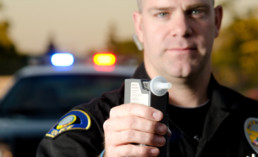Blood Alcohol Content Is Measured Using NIR Spectroscopy
Breathalyzer tests are the most common devices used for detecting Blood Alcohol Content. They work by estimating BAC from a breath sample and are utilized mostly by law enforcement in conjunction with a field sobriety test. Police use these two means together to determine whether a driver has been drinking. Every state now has the same limit of .08% for BAC of drivers – although based on a person’s weight and size, the amount of alcohol to reach .08% varies per individual. A reading at or above the legal limit on a breathalyzer can often result in a DWI or DUI as well as other penalties.
The original breathalyzer, which was invented in 1954, used a combination of chemical oxidation and light measurement to calculate the amount of alcohol. Now, most handheld breathalyzers employ electrochemical platinum fuel cell analysis and larger breathalyzers utilize the technology of spectroscopy. These table-top breathalyzers are generally located inside police stations.
An NIR spectrophotometer works to find BAC by identifying molecules based on how they absorb light. Ethanol alcohol oxidizes into carboxylic acid and uses Potassium dichromate as an oxidizing agent in a solution of yellow sulfuric acid. With Silver Nitrate as a catalyst, this reaction happens extremely quickly. When the Potassium dichromate reacts to the ethanol’s oxidization, the chromate ion changes and changes the color intensity of the yellow solution. The spectrophotometer then compares its light absorbance with that of a pure solution. Using this technique, it is able to measure the amount of alcohol present, which the breathalyzer then outputs as a percentage.
Now, NIR spectroscopy technology may allow alcohol content to be detected in an even less invasive manner – through the skin. A light is beamed into the skin of the person’s forearm and its reflection is measured by the NIR spectrophotometer. Since each molecule reflects a unique light, the spectrophotometer can determine the difference between alcohol, water, and other liquid particles in the skin. The alcohol molecules are distinguished from the others and can then be measured from this process. This method can provide extremely accurate results in under a minute. Devices with this technology may be the future of calculating Blood Alcohol Content.
For more information on spectrophotometers and the services they can provide, visit sensing.konicaminolta.us/us.










